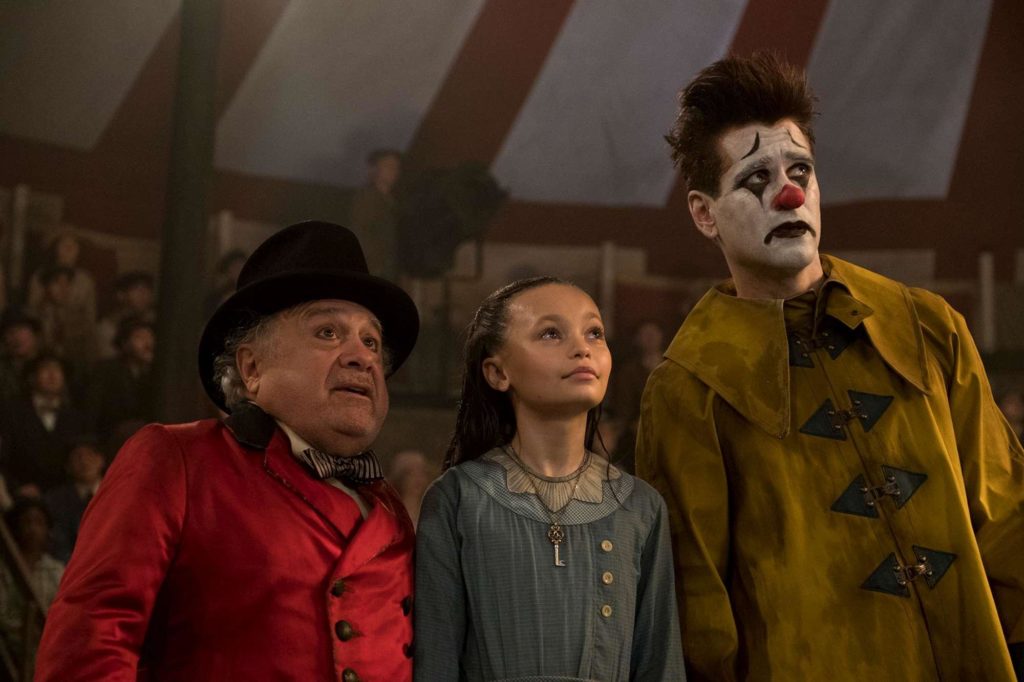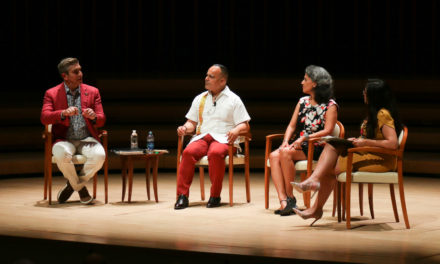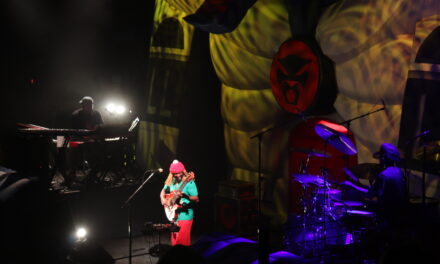
Max Medici (Danny DeVito), Milly Farrier (Nico Parker) and Holt Farrier (Colin Farrell) wait for Dumbo to glide above a crowd of glaring spectators. /Courtesy of Jay Maidment/Disney
The live-action adaptation of Disney’s 1941 animated classic “Dumbo” receives the classic Tim Burton treatment: eccentric characters, extravagant sets and a dark color palette. But don’t be deceived by the moody coloration — this film is a heartwarming treat.
Burton’s “Dumbo” focuses more heavily than its predecessor on human characters. The story opens with the famous circus-horse rider Holt Farrier’s (Colin Farrell) return from France during World War II. Upon arrival, he finds that the Medici Brothers’ circus has fallen on hard times and, as a result, sold the horses for his show. Ringmaster Max Medici (Danny DeVito) coaxes Farrier to train Dumbo, a baby elephant with enormous ears. When Farrier’s two children realize that, with the help of a feather, Dumbo can use his ears to fly, Dreamland amusement park owner V.A. Vandevere (Michael Keaton) and his star acrobat Colette Marchant (Eva Green) offer Medici and his troupe a place at Dreamland in hopes of making Dumbo their main attraction.
Unlike in Disney’s original, the animals in Burton’s “Dumbo” do not speak, which means that a whole slew of beloved characters, such as Timothy Q. Mouse and the gossiping elephants, were cut from the remake. Luckily, the addition of new human characters more than makes up for this absence. The Farrier children, Milly (Nico Parker) and Joe Farrier (Finley Hobbins), become Dumbo’s first real friends and help him break out of his shell. Milly’s quick wit and bravery make her a standout; in fact, she saves Dumbo’s first performance when she climbs to perilous heights to give him a feather. Although only a child herself, the character should be a role model for the children who see her on screen. Likewise, it is inspiring to watch her father, Holt, overcome grief to become a more altruistic person. In the end, he becomes willing to risk everything — at one point climbing the outside of a lofty circus tent — to help Dumbo escape bondage. Farrell puts his heart into this role, and the Irish native also nails the American Southern accent.
Like in Burton’s “Big Fish” and “Alice in Wonderland,” the massive sets and colorful costumes in “Dumbo” will transport you to another world. Burton effectively brings circus ambiance to life through sound and light. When you witness Dumbo perform under the blazing circus lights and hear the gasps of wonder in its stands, you’ll likely feel like you’re under the big top, too.
If the original holds a special place in your heart, you’ll be happy to know that the film doesn’t forget its roots. There are plenty of Easter eggs, like the train’s smiling face, throughout the movie. Down to its smallest details, the film manages to pay homage to the cartoon.
Although “Dumbo” includes a surprising amount of humor, its jokes don’t always land. Still, a running joke with Medici and an escaped monkey is bound to make you laugh, thanks to DeVito’s charismatic and comedic persona. J. Griffin Remington (Alan Arkin), a wealthy investor, is also a hilarious presence on screen, mostly because of how out-of-place he seems in the movie. Other attempts at humor aren’t quite as successful — like when Holt avoids getting spotted as a elephant handler by donning a fake moustache.
While “Dumbo” lets us witness magic in live action, it seems unlikely that it will be remembered as a remake that equals the original. One key reason for this is that the film drags on for longer than it should; while the 1941 classic clocked in at just 64 minutes and is one of the shortest Disney movie to date, Burton’s version nearly doubles the original’s length at 112 minutes. By the third time I saw Dumbo fly around the tent for a group of mesmerized circus-goers, the magic was already gone. In the cartoon, the flying act is the climax of the film — it is the moment that Dumbo finally proves his worth to the world. The shorter movie provided poignant character moments for Dumbo, and the remake has those too, but it forgets that the flying aspect of Dumbo is only half of what makes him special.
Additionally, an upbeat song or two could have lightened the film’s dark atmosphere. After all, what’s a Disney movie without a few musical numbers here and there? Burton’s real-world version of “Dumbo” includes none, and this is the only time I have objected to such a detail. The truth is that the source material does not lend itself well to being stretched to nearly two hours — it needs something to break up the seriousness. Music would have been an obvious choice, as it would have fit the playful and loud circus setting perfectly.
The pioneer cartoon told a good story; it was succinct and taught children to embrace what made them unique. While Burton’s remake offers the same message, it delivers it through a convoluted plot, causing the third act of the film to grow messy. This film has too many characters and doesn’t seem to know what to do with them. Consequently, not all the characters receive satisfactory conclusions to their stories.
Burton’s “Dumbo” offers some spectacular visuals that are alone worth buying a ticket for, but be warned — it’s a long Disney movie with no fun musical numbers. Where the original excels in its storytelling, Burton’s version excels in delivering moments of visual splendor. While not a perfect film, it is an above-average try at revitalizing a time-honored, heartwarming tale.
Grade: B-
Noah Whitfield (20C) is from Johannesburg, South Africa, majoring in creative writing and minoring in Spanish. His interests include making music, writing scripts and watching movies. Contact Whitfield at noah.christopher.whitfield@emory.edu.





